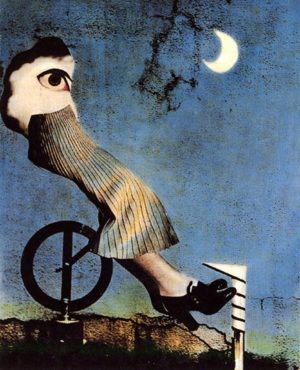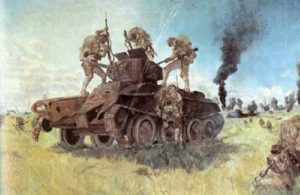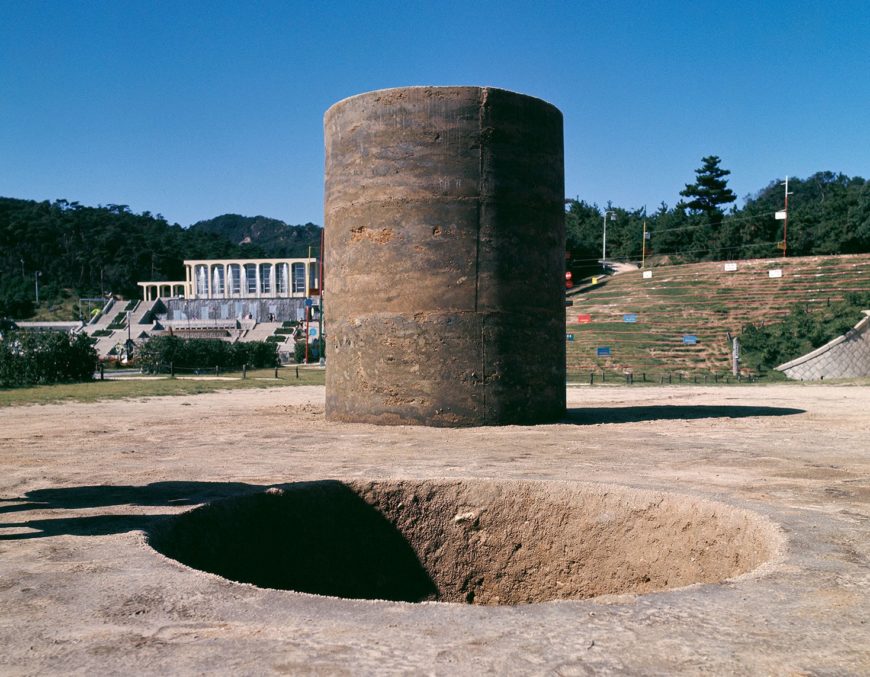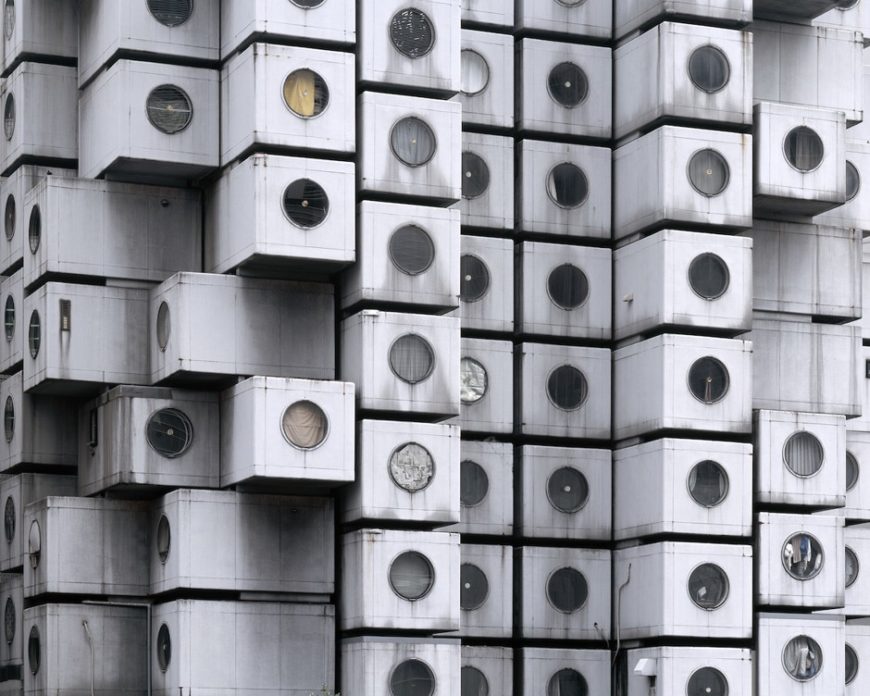
Hirai Teruschichi, Fantasies of the Moon, 1938, gelatin silver print, painted collage (© Tokyo Metropolitan Foundation for History and Culture, image: Tokyo Digital Museum)
Shōwa period (1926–1989)
The years leading to Japan’s involvement in World War II saw the rise of militarism, ultra-nationalism, and increasing imperialistic ambitions, fueled in part by Japan’s emulation of western colonialism. In the 1920s and 30s, Japanese poets, photographers, and painters who had studied abroad developed, in Japan, styles aligned with contemporaneous global art movements, combining elements of surrealism, absurdist Dada, and futurism. For example, the paintings of Fukuzawa Ichirō combined surrealist imagery with political commentary; Hirai Terushichi made use of color painting and photomontage to create photographic prints that blurred the boundary between reality and imagination.

Leonard Tsuguharu Foujita, Battle on the Bank of the Halha, 1941, oil on canvas (National Museum of Modern Art, Tokyo)
Such artists were silenced in 1941 by the Japanese “thought police” that aimed to control any and all ideologies that seemed to pose a threat to the ideals and agenda of the Nazi-allied Empire of Japan. War-time painting depicting military men and battles came to be heavily criticized after the war for their political charge, but recent scholarship by Ikeda Asato suggests that seemingly apolitical paintings of the pre-war period, which romanticized subjects of “authentic” Japanese culture such as Mount Fuji or bijin (“beautiful women”), can also be understood as having supported the militaristic state ideology of the time.
Postwar Japan was a period of unprecedented change. From the end of the war in 1945 to 1952, Japan was occupied by the victorious Allied forces, led by American General Douglas MacArthur. From 1952 to the death of the Shōwa emperor (Hirohito) in 1989, Japan witnessed a successful U.S.-influenced economic redevelopment. In the cultural sphere, as early as 1954, the newly established Gutai art association promoted “concrete” or “embodied” artistic expressions, pushing abstraction to its limits and foreshadowing the performance and conceptual art of the 1960s and 70s.

Sekine Nobuo, Phase: Mother Earth, 1968, earth and cement, 220 x 270 cm (equally sized hole and cylinder) (Kobe Suma Rikyū Park Contemporary Sculpture Exhibition, 1968, image: Murai Osamu, CC BY-SA 4.0)
In those later decades, the exploration of materiality continued to preoccupy artists of the so-called mono-ha (literally “school of things”), including the Korean Lee Ufan. Mono-ha artists created works that tested the tension between natural and manmade materials and between their chosen materials and the environment in which they were placed. Mono-ha artists may have been influenced by the sociopolitical climate of distrust, protest, and counterculture that dominated the 60s and 70s. Referring to one of his most influential works, Phase: Mother Earth, consisting of a deep and wide hole in the ground and an equally sized cylinder of the excavated earth, the Mono-ha artist Sekine Nobuo affirmed:
“If you dig a hole in the earth and keep digging forever, (…) and if you go on to pull out all the earth, [the Earth] will be reversed into a negative version of itself.”Sekine Nobuo cited in Reconsidering Mono-ha, The National Museum of Art, Osaka, 2005, p. 74
The Great Kantō earthquake of 1923 and the ravages of war created successive scenes of destruction and contributed to a collective memory of ruins, used as evocative subject matter by Japanese painters and photographers to this day.
In the postwar period, reconstruction was not only political and economic, but also literal, in the urban and architectural sense. Modernism was adopted as the language of this reconstruction. The architect Tange Kenzo, who worked for Maekawa Kunio, one of Le Corbusier’s disciples, became one of the most consequential postwar modernists both as an architect and as an urban planner.

Kurokawa Kisho, the Nakagin Capsule Tower, Tokyo, completed 1972, detail of exterior view of prefabricated units (image: City Lab)
Tange’s unrealized “Plan for Tokyo 1960” heavily influenced the Metabolist movement, which Tange himself supported. Emblematic of Metabolism is the Nakagin Capsule Tower in Shinbashi, Tokyo, whose capsule-like rooms are prefabricated units meant to be replaced once they wore out. The “capsules” were designed as integral to a megastructure of both permanent and impermanent parts, built in the spirit of organic growth.

